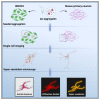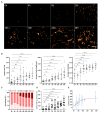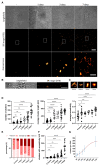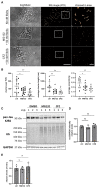Super-resolution imaging unveils the self-replication of tau aggregates upon seeding
- PMID: 37393617
- PMCID: PMC7614924
- DOI: 10.1016/j.celrep.2023.112725
Super-resolution imaging unveils the self-replication of tau aggregates upon seeding
Abstract
Tau is a soluble protein interacting with tubulin to stabilize microtubules. However, under pathological conditions, it becomes hyperphosphorylated and aggregates, a process that can be induced by treating cells with exogenously added tau fibrils. Here, we employ single-molecule localization microscopy to resolve the aggregate species formed in early stages of seeded tau aggregation. We report that entry of sufficient tau assemblies into the cytosol induces the self-replication of small tau aggregates, with a doubling time of 5 h inside HEK cells and 1 day in murine primary neurons, which then grow into fibrils. Seeding occurs in the vicinity of the microtubule cytoskeleton, is accelerated by the proteasome, and results in release of small assemblies into the media. In the absence of seeding, cells still spontaneously form small aggregates at lower levels. Overall, our work provides a quantitative picture of the early stages of templated seeded tau aggregation in cells.
Keywords: Alzheimer’s disease; CP: Cell biology; neurodegeneration; protein aggregation; seeded aggregation; super-resolution microscopy; tau.
Copyright © 2023 The Authors. Published by Elsevier Inc. All rights reserved.
Conflict of interest statement
Declaration of interests G.M. is an employee of WaveBreak Therapeutics. E.D. is now an employee of AstraZeneca.
Figures








References
Publication types
MeSH terms
Substances
Grants and funding
LinkOut - more resources
Full Text Sources
Medical
Research Materials
Miscellaneous

